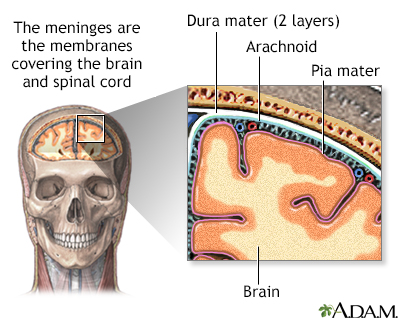Opisthotonos
Back arching; Abnormal posturing - opisthotonos; Decerebrate posture - opisthotonos
Opisthotonos is a condition in which a person holds their body in an abnormal position. The person is usually rigid and arches their back, with their head thrown backward. If a person with opisthotonos lies on their back, only the back of their head and heels touch the surface they are on.
Images

Considerations
Opisthotonos is much more common in infants and children than in adults. It is also more extreme in infants and children because of their less mature nervous systems.
Causes
Opisthotonos may occur in infants with meningitis. This is an infection of the meninges, the membranes that cover the brain and spinal cord. Viruses, malaria, and syphilis are infections associated with opisthotonos. It may also occur as a sign of reduced brain function or injury to the nervous system.
Other causes may include:
- Arnold-Chiari syndrome, a problem with the structure of the brain
- Brain tumor
- Cerebral palsy
- Gaucher disease, which causes a buildup of fatty tissue in certain organs
- Growth hormone deficiency (occasionally)
- Poisoning including strychnine, some street drugs, and some medicines
- Metabolic disorders that run in families, such as glutaric aciduria and organic acidemias, Krabbe disease, maple syrup urine disease, and others
- Seizures
- Severe electrolyte imbalance
- Traumatic brain injury
- Stiff-person syndrome (a condition that makes a person rigid and have spasms)
- Bleeding in the brain
- Tetanus
Some antipsychotic medicines can cause a side effect called acute dystonic reaction. Opisthotonos may be part of this reaction.
In rare cases, infants born to women who drink large amounts of alcohol during pregnancy may have opisthotonos due to alcohol withdrawal.
Home Care
A person who develops opisthotonos will need to be cared for in a hospital.
When to Contact a Medical Professional
Go to the emergency room or call 911 or the local emergency number if symptoms of opisthotonos occur. Typically, opisthotonos is a symptom of other conditions that are serious enough for a person to seek medical attention.
What to Expect at Your Office Visit
This condition will be evaluated in a hospital, and emergency measures may be taken.
Your health care provider will perform a physical examination and ask about symptoms to look for the cause of opisthotonos
Questions may include:
- When did the symptoms start?
- Is the body positioning always the same?
- What other symptoms came before or with the abnormal positioning (such as fever, stiff neck, or headache)?
- Is there any recent history of illness?
The physical examination will include a complete checkup of the nervous system.
Tests may include:
- Blood and urine tests
- Cerebrospinal fluid (CSF) culture and cell counts
- CT scan of the head
- Electrolyte analysis
- Lumbar puncture (spinal tap)
- MRI of the brain
Treatment will depend on the cause. For example, if meningitis is the cause, medicines may be given.
Related Information
MeningitisReferences
Berger JR, Price R. Stupor and coma. In: Jankovic J, Mazziotta JC, Pomeroy SL, Newman NJ, eds. Bradley and Daroff’s Neurology in Clinical Practice. 8th ed. Philadelphia, PA: Elsevier; 2022:chap 5.
Birch TB, Bleck TP. Tetanus (Clostridium tetani). In: Bennett JE, Dolin R, Blaser MJ, eds. Mandell, Douglas, and Bennett's Principles and Practice of Infectious Diseases. 9th ed. Philadelphia, PA: Elsevier; 2020:chap 244.
Kliegman RM, St. Geme JW, Blum NJ, Shah SS, Tasker RC, Wilson KM. Defects in metabolism of amino acids. In: Kliegman RM, St. Geme JW, Blum NJ, Shah SS, Tasker RC, Wilson KM, eds. Nelson Textbook of Pediatrics. 21st ed. Philadelphia, PA: Elsevier; 2020:chap 103.
BACK TO TOPReview Date: 4/29/2023
Reviewed By: Joseph V. Campellone, MD, Department of Neurology, Cooper Medical School of Rowan University, Camden, NJ. Review provided by VeriMed Healthcare Network. Also reviewed by David C. Dugdale, MD, Medical Director, Brenda Conaway, Editorial Director, and the A.D.A.M. Editorial team.

Health Content Provider
06/01/2025
|
A.D.A.M., Inc. is accredited by URAC, for Health Content Provider (www.urac.org). URAC's accreditation program is an independent audit to verify that A.D.A.M. follows rigorous standards of quality and accountability. A.D.A.M. is among the first to achieve this important distinction for online health information and services. Learn more about A.D.A.M.'s editorial policy, editorial process and privacy policy. A.D.A.M. is also a founding member of Hi-Ethics. This site complied with the HONcode standard for trustworthy health information from 1995 to 2022, after which HON (Health On the Net, a not-for-profit organization that promoted transparent and reliable health information online) was discontinued. |
The information provided herein should not be used during any medical emergency or for the diagnosis or treatment of any medical condition. A licensed medical professional should be consulted for diagnosis and treatment of any and all medical conditions. Links to other sites are provided for information only -- they do not constitute endorsements of those other sites. © 1997- 2025 A.D.A.M., a business unit of Ebix, Inc. Any duplication or distribution of the information contained herein is strictly prohibited.
